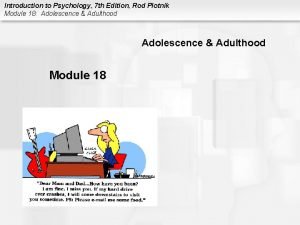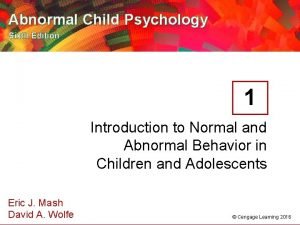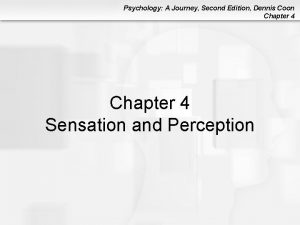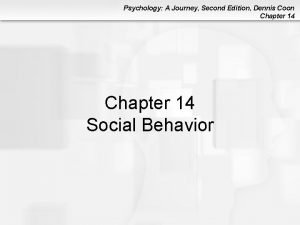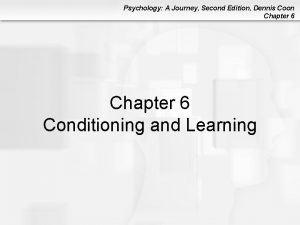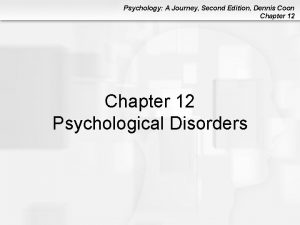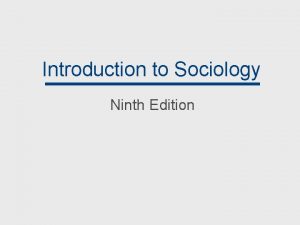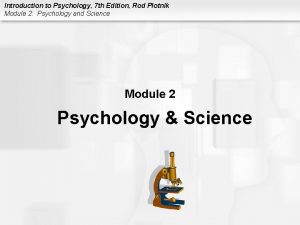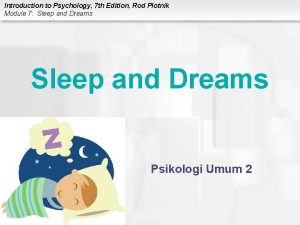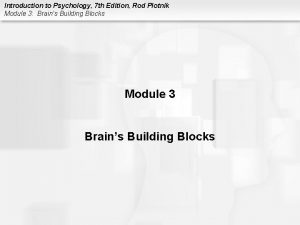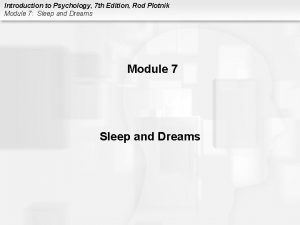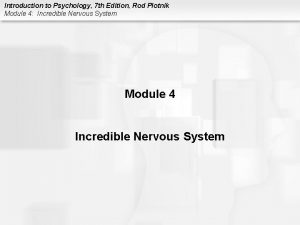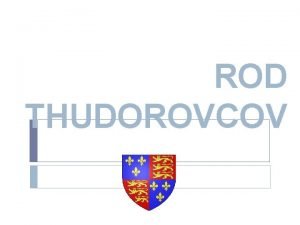Introduction to Psychology 7 th Edition Rod Plotnik
































- Slides: 32

Introduction to Psychology, 7 th Edition, Rod Plotnik Module 18: Adolescence & Adulthood Module 18

Introduction to Psychology, 7 th Edition, Rod Plotnik Module 18: Adolescence & Adulthood PUBERTY AND SEXUAL BEHAVIOR • Girls during puberty – Puberty sets off physical growth • starts 9. 6 years • begins 6 -12 months before breast development – Puberty triggers a physiological process: female sexual maturity – Menarche • first menstrual period (ovulation may have occurred) • estrogen • levels increase eightfold • stimulates the development of both primary and secondary sexual characteristics

Introduction to Psychology, 7 th Edition, Rod Plotnik Module 18: Adolescence & Adulthood PUBERTY AND SEXUAL BEHAVIOR • Girls during puberty – Female secondary sexual characteristics • triggered by increase of estrogen secretion • includes growth of pubic hair, development of breasts, and widening of hips • begins about 10. 5 years • continues for about 4 to 5 years

Introduction to Psychology, 7 th Edition, Rod Plotnik Module 18: Adolescence & Adulthood PUBERTY AND SEXUAL BEHAVIOR (CONT. ) • Boys during puberty – Triggers an increase in physical growth (height) age 13 -14 – Male sexual maturity, includes growth of genital organs • begins around age 11 and continues for approximately three years • sperm production begins around the age 12 -14 – Male secondary characteristics • triggered by increased secretion of testosterone; include growth of pubic hair, facial hair, development of muscles, and a change (deepening) in voice • occur between 12 and 16

Introduction to Psychology, 7 th Edition, Rod Plotnik Module 18: Adolescence & Adulthood COGNITIVE & EMOTIONAL CHANGES • • Definition – refers to how a person perceives, thinks, and gains an understanding of his or her world through the interaction and influence of genetic and learned factors Piaget’s Cognitive Stages: continued – Stage 4: Formal Operations • last of Piaget’s four cognitive stages • extends from about age 12 through adulthood • adolescents and adults develop the abilities to think about abstract or hypothetical concepts • consider an issue from another’s viewpoint, and solve cognitive problems in a logical way

Introduction to Psychology, 7 th Edition, Rod Plotnik Module 18: Adolescence & Adulthood COGNITIVE & EMOTIONAL CHANGES (CONT. ) • Brain development: reason and emotion – Prefrontal cortex: executive functions • located near the front of the brain – Vulnerability • around age 11 and continuing into young adult hood, the brain rewires and reorganizes • especially vulnerable to traumatic adolescent experiences such as: physically or sexually abused, bullied, feeling lonely, rejected, or depressed, and abusing drugs

Introduction to Psychology, 7 th Edition, Rod Plotnik Module 18: Adolescence & Adulthood COGNITIVE & EMOTIONAL CHANGES (CONT. ) • Brain development: reason and emotion – Prefrontal cortex: executive functions • risk-taking behavior • explains the adolescent’s brain (not being fully developed) allows for risky or irresponsible behavior • feel invulnerable and have no fear of accidents

Introduction to Psychology, 7 th Edition, Rod Plotnik Module 18: Adolescence & Adulthood COGNITIVE & EMOTIONAL CHANGES (CONT. ) • Brain development: reason and emotion – Limbic system: emotional behaviors • teenagers have less control over their emotional and impulsive behaviors • moody, emotional, and impulsive behaviors • involved in a wide range of emotional behaviors, such as: • being ecstatic over getting a date • feeling depressed when failing a test • getting angry when being insulted • increased structure and function of the limbic system accounts for a teenager’s irritability as well as increase in aggression in adolescent males

Introduction to Psychology, 7 th Edition, Rod Plotnik Module 18: Adolescence & Adulthood COGNITIVE & EMOTIONAL CHANGES (CONT. ) • Kohlberg’s theory of moral reasoning – Three levels of moral reasoning 1. Self-Interest: Preconventional level • lowest level of moral reasoning • stage 1, moral decisions are based primarily on fear of punishment or the need to be obedient • stage 2, moral reasoning is guided most by satisfying one’s self-interest • may involve bargaining

Introduction to Psychology, 7 th Edition, Rod Plotnik Module 18: Adolescence & Adulthood • Kohlberg’s theory of moral reasoning – Three levels of moral reasoning 2. Social approval: Conventional level • represents an intermediate level of moral reasoning • stage 3, moral decisions are guided most by conforming t the standards of others we value • stage 4, moral reasoning is determined most by conforming to laws and society COGNITIVE & EMOTIONAL CHANGES (CONT. )

Introduction to Psychology, 7 th Edition, Rod Plotnik Module 18: Adolescence & Adulthood COGNITIVE & EMOTIONAL CHANGES (CONT. ) • Kohlberg’s theory of moral reasoning – Three levels of moral reasoning 3. Abstract ideas: Postconventional level • stage 5, moral decisions are made after carefully thinking about all the alternatives and striking a balance between human rights and laws of society • stage 6, has been omitted because few people have reached it

Introduction to Psychology, 7 th Edition, Rod Plotnik Module 18: Adolescence & Adulthood COGNITIVE & EMOTIONAL CHANGES (CONT. ) • • Parenting Styles and Effects Different styles of parenting – Authoritarian parents • attempt to shape, control, and evaluate the behavior and attitudes of their children in accordance with a set standard of conduct • absolute standard that comes from religious or respected authorities

Introduction to Psychology, 7 th Edition, Rod Plotnik Module 18: Adolescence & Adulthood COGNITIVE & EMOTIONAL CHANGES (CONT. ) • • Parenting Styles and Effects Different styles of parenting – Authoritative parents • attempt to direct their children’s activities in a rational and intelligent way • supportive, loving, committed, encourage verbal give and take, and discuss their rules and policies with their children

Introduction to Psychology, 7 th Edition, Rod Plotnik Module 18: Adolescence & Adulthood COGNITIVE & EMOTIONAL CHANGES (CONT. ) • Parenting Styles and Effects • Different styles of parenting – Permissive parents • less controlling and behave with a nonpunishing and accepting attitude toward their children’s impulses, desires, and actions • consult with their children about policy decisions, make few demands, and tend to use reason rather than direct power

Introduction to Psychology, 7 th Edition, Rod Plotnik Module 18: Adolescence & Adulthood COGNITIVE & EMOTIONAL CHANGES (CONT. ) • Beyond adolescence – Changes in cognitive speed • 20 to 40 cognitive skills remain relatively stable • 40 to 80, general slowing of some cognitive processes • late 50’s slowing in processing speed • late 50’s slowing in perceptual; speed – Changes in memory • 40’s and continuing into old age, most people complain about not remembering things

Introduction to Psychology, 7 th Edition, Rod Plotnik Module 18: Adolescence & Adulthood PERSONALITY & SOCIAL CHANGES • • Personality and social development – refers to how a person develops a sense of self or self-identity, develops relationships with others, and develops the skills useful in social interactions Personal identity or self-identity – refers to how we describe ourselves and includes our values, goals, traits, perceptions, interests, and motivations

Introduction to Psychology, 7 th Edition, Rod Plotnik Module 18: Adolescence & Adulthood PERSONALITY & SOCIAL CHANGES (CONT. ) • Development of self-esteem – Self-esteem • how much we like ourselves and how much we value our self-worth, importance, attractiveness, and social competence – High self-esteem-develop and maintain high levels • 60% of adolescents develop and maintain a strong sense of self-esteem through junior high school • do well in school, develop rewarding friendships, participate in social activities, and are described as cheerful, assertive, emotionally warm, and unwilling to give up if frustrated

Introduction to Psychology, 7 th Edition, Rod Plotnik Module 18: Adolescence & Adulthood PERSONALITY & SOCIAL CHANGES (CONT. ) • Development of self-esteem – Low self-esteem-develop and maintain low levels • 15% of adolescents develop and maintain a chronically low self-esteem through junior high school • have continuing personal and social problems (shy, lonely, depressed), which have been present for some time and contribute to low self-esteem – Reversals-reverse levels • 25% of adolescents show dramatic reversals in self-esteem, either from high to low or low to high

Introduction to Psychology, 7 th Edition, Rod Plotnik Module 18: Adolescence & Adulthood PERSONALITY & SOCIAL CHANGES (CONT. ) • Development of self-esteem – Forces shaping self-esteem • girls – are dependent upon the ability to relate well to others – are more likely to be the ones showing declining or low self-esteem • boys – are dependent upon looking cool in public, which means not letting stress or anxiety make them look bad – are more likely to show increasing or high levels of self-esteem

Introduction to Psychology, 7 th Edition, Rod Plotnik Module 18: Adolescence & Adulthood PERSONALITY & SOCIAL CHANGES (CONT. ) • Adulthood: Erikson’s Psychosocial Stages – Stage 5: Identity versus role confusion • adolescence (12 -20) • adolescents need to leave behind the carefree, irresponsible, and impulsive behaviors of childhood and develop the more purposeful, planned, and responsible behaviors of adulthood • if successful, develop a healthy and confident sense of identity • if unsuccessful, experience role confusion, • results in having low-self esteem and becoming unstable or socially withdrawn

Introduction to Psychology, 7 th Edition, Rod Plotnik Module 18: Adolescence & Adulthood PERSONALITY & SOCIAL CHANGES (CONT. ) • Adulthood: Erikson’s Psychosocial Stages – Stage 6: Intimacy versus isolation • young adulthood (20 -40) • young adulthood is a time for finding intimacy by developing loving and meaningful relationships • can find intimacy in caring relationships • negative side, without intimacy, we will have a painful feeling of isolation, and our relationships will be impersonal

Introduction to Psychology, 7 th Edition, Rod Plotnik Module 18: Adolescence & Adulthood PERSONALITY & SOCIAL CHANGES (CONT. ) • Adulthood: Erikson’s Psychosocial Stages – Stage 7: Generativity versus stagnation • middle adulthood (40 -65) • time for helping the younger generation develop worthwhile lives • positive: achieve generativity through raising our own children • also by mentoring at work and helping others • negative: lack of involvement leads to a feeling of stagnation, of having done nothing for the younger generation

Introduction to Psychology, 7 th Edition, Rod Plotnik Module 18: Adolescence & Adulthood PERSONALITY & SOCIAL CHANGES (CONT. ) • Adulthood: Erikson’s Psychosocial Stages – Stage 8: Integrity versus despair • late adulthood (65 and older) • time for reflecting on and reviewing how we met previous challenges and lived our lives • positive side: if we can look back and feel content about how we lived and what we accomplished, we will have a feeling of satisfaction or integrity • negative side: if we reflect and see a series of crises, problems, and bad experiences, we will have a feeling of regret and despair

Introduction to Psychology, 7 th Edition, Rod Plotnik Module 18: Adolescence & Adulthood GENDER ROLES, LOVE & RELATIONSHIP • Definition: Gender Roles – Gender roles • traditional or stereotypic behaviors, attitudes, values, and personality traits that society says are how males and females are to think and behave – U. S. gender roles • female gender role includes being caring, insecure, helpful, emotional, social, and shy • male gender role includes being arrogant, self-confident, aggressive, ambitious, not emotional, and dominant

Introduction to Psychology, 7 th Edition, Rod Plotnik Module 18: Adolescence & Adulthood GENDER ROLES, LOVE & RELATIONSHIP (CONT. ) • Definition: Gender Roles – Worldwide gender roles • male gender roles include being ambitious, dominant, and independent • female gender roles include being submissive, affectionate, and emotional • differences in gender roles are clearly defined because society (family, peers, bosses, and colleagues) encourages and rewards behaviors and thoughts that match expected gender roles and discriminate against those that do not fit

Introduction to Psychology, 7 th Edition, Rod Plotnik Module 18: Adolescence & Adulthood GENDER ROLES, LOVE & RELATIONSHIP (CONT. ) • Gender roles: development and function – Evolutionary Psychology Theory • emphasizes genetic and biological forces and says that current gender differences are a continuation of the behaviors that evolved from early men and women who adapted these different behaviors in their attempts to survive the problems of their time – Social Role Theory • emphasizes social and cultural influences and states that gender differences between males and females arise from different divisions of labor

Introduction to Psychology, 7 th Edition, Rod Plotnik Module 18: Adolescence & Adulthood GENDER ROLES, LOVE & RELATIONSHIP (CONT. ) • Kinds of love – Passionate love • involves continuously thinking about the loved one and is accompanied by warm sexual feelings and powerful emotional reactions – Companionate love • involves having trusting and tender feelings for someone whose life is closely bound up with one’s own

Introduction to Psychology, 7 th Edition, Rod Plotnik Module 18: Adolescence & Adulthood p 419 THREE COMPONENTS LOVE

Introduction to Psychology, 7 th Edition, Rod Plotnik Module 18: Adolescence & Adulthood GENDER ROLES, LOVE & RELATIONSHIP (CONT. ) • Kinds of love – Triangular theory of love • Passion – feeling physically aroused and attracted to someone • Intimacy – feeling close and connected to someone – develops through sharing and communicating • Commitment – making a pledge to nourish the feelings of love and to actively maintain the relationship

Introduction to Psychology, 7 th Edition, Rod Plotnik Module 18: Adolescence & Adulthood PHYSICAL CHANGES: AGING • Kinds of aging – Normal aging • gradual and natural slowing of our physical and psychological processes from middle through late adulthood – Pathological aging • caused by genetic defects, physiological problems, or diseases, such as Alzheimer’s – Gerontology • study of aging

Introduction to Psychology, 7 th Edition, Rod Plotnik Module 18: Adolescence & Adulthood PHYSICAL CHANGES: AGING (CONT. ) • Sexual changes with aging: women – physical symptoms • hot flashes, some sleep disturbance, and dryness of the vagina, which results from a decrease and eventual stoppage in the secretion of estrogen – psychological symptoms • moodiness, depression, anxiety, and anger – sexual activities • women who experienced sexual activity as fulfilling and enriching before menopause will likely continue to enjoy sexual activity after menopause and into late adulthood

Introduction to Psychology, 7 th Edition, Rod Plotnik Module 18: Adolescence & Adulthood PHYSICAL CHANGES: AGING (CONT. ) • Sexual changes with aging: men – Sexual responding • older men may require more time and stimulation to have an erection • healthy men usually have no difficulty in becoming sexually aroused or reaching orgasm – Physiological problems • Some men see their decreased sexual abilities as a threat to their self-esteem
 Introduction to psychology rod plotnik
Introduction to psychology rod plotnik Ta ta ta ta
Ta ta ta ta Plotnik
Plotnik Mis chapter 6
Mis chapter 6 Mis
Mis Psychology ninth edition in modules
Psychology ninth edition in modules David myers psychology 9th edition
David myers psychology 9th edition Lazarus's appraisal theory
Lazarus's appraisal theory Psychology eighth edition david g myers
Psychology eighth edition david g myers Abnormal child psychology 6th edition
Abnormal child psychology 6th edition David g myers psychology 8th edition
David g myers psychology 8th edition Fundamentals of abnormal psychology ninth edition
Fundamentals of abnormal psychology ninth edition General adaptation syndrome
General adaptation syndrome Social psychology ninth edition
Social psychology ninth edition Psychology a journey 4th edition chapter 1
Psychology a journey 4th edition chapter 1 Psychology a journey 4th edition chapter 1
Psychology a journey 4th edition chapter 1 Psychology a journey 4th edition chapter 1
Psychology a journey 4th edition chapter 1 Psychology a journey
Psychology a journey Psychology tenth edition david g myers
Psychology tenth edition david g myers Psychology ninth edition in modules
Psychology ninth edition in modules Marketing an introduction 6th canadian edition
Marketing an introduction 6th canadian edition Introduction to teaching becoming a professional
Introduction to teaching becoming a professional Introduction to sociology 9th edition
Introduction to sociology 9th edition Introduction to radar systems skolnik 3rd edition pdf
Introduction to radar systems skolnik 3rd edition pdf Introduction to information systems 6th edition
Introduction to information systems 6th edition Introduction to information systems 6th edition
Introduction to information systems 6th edition Microbiology an introduction 9th edition
Microbiology an introduction 9th edition Introduction to information systems 3rd edition
Introduction to information systems 3rd edition Introduction to information systems 5th edition
Introduction to information systems 5th edition Introduction to hospitality 7th edition
Introduction to hospitality 7th edition Introduction to hospitality 7th edition
Introduction to hospitality 7th edition John r walker introduction to hospitality management
John r walker introduction to hospitality management Introduction to algorithms 2nd ed
Introduction to algorithms 2nd ed
